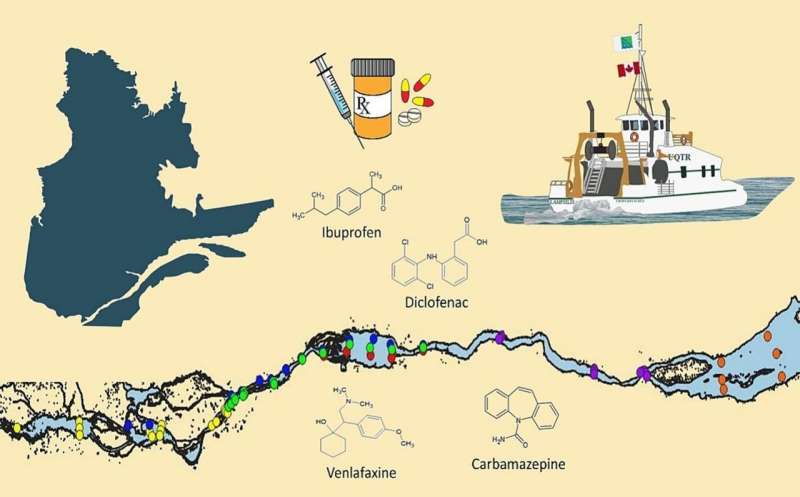This article has been reviewed according to Science X's editorial process and policies. Editors have highlighted the following attributes while ensuring the content's credibility:
fact-checked
trusted source
proofread
Medicinal drugs pollute the St. Lawrence River, presenting possible risk to aquatic organisms: Study

A new study shows troubling levels of pharmaceutical pollution in the St. Lawrence River and its largest tributaries, especially near and downstream of urban areas. Some of the compounds detected even pose a moderate-to-high risk to aquatic organisms when there's chronic exposure.
Université de Montréal doctoral student Marc-Antoine Vaudreuil conducted the study under the supervision of Sébastien Sauvé, an environmental chemist and professor in the Department of Chemistry. From 2017 to 2021, Vaudreuil took part in a five-year field research program, collecting surface water samples along a 700-kilometer stretch of the 3,000-kilometer river.
The results show that despite the St. Lawrence waters' significant dilution effect, concentrations of four compounds—caffeine, carbamazepine, diclofenac and ibuprofen—are high enough to negatively impact growth and reproduction in aquatic fauna.
"Some concentrations exceeded toxicity thresholds for long-term exposure in aquatic life, but for most pharmaceutical compounds, there are currently no Canadian environmental standards," said Vaudreuil.
"With the exception of carbamazepine, most of the compounds do not cause immediate harm, because they degrade fairly rapidly. However, it appears that chronic exposure can be very toxic, especially to organisms in the early stages of growth, such as newly hatched fish."
Vaudreuil added that pharmaceutical contamination of our water resources can also indirectly contribute to antibiotic resistance, which has become a major threat to global health.
Montreal: A case study
The data show that water downstream of Montreal has significantly higher concentrations of pharmaceutical compounds than water in other parts of the St. Lawrence. The contamination extends to Lac Saint-Pierre, 70 kilometers downstream.
"It's amazing that there are still traces so far from Montreal," said Sauvé. "We would expect more contamination in the immediate vicinity of the island given that the city has a population of two million and only one wastewater treatment plant to treat 900 billion liters of water per year."
The wastewater treatment technologies currently used in Montreal were not designed to remove pharmaceutical compounds and often have little or no effectiveness for this purpose.
However, Montreal is working on adding ozonation technology to its wastewater treatment facilities, which will remove up to 80 percent of pharmaceuticals.
"But it's a double-edged sword," Sauvé said. "The system has to be properly designed because ozone transforms pharmaceutical waste into even more toxic compounds. So you need enough ozone to eliminate these new molecules, too."
Reducing chemical loads
Upgrading wastewater treatment systems will reduce chemical loads and help improve water quality in the St. Lawrence, which is a source of drinking water for millions of people.
But Sauvé suggests other approaches be considered, too: for example, targeting wastewater discharge from sites known to produce large quantities of pharmaceutical waste, such as hospitals and nursing homes.
On a smaller scale, he applauds the efforts of the pharmaceutical industry and the public to properly dispose of expired and unused medications.
"We also have to remember that the pharmaceutical compounds in wastewater come from the medications we all take," said Sauvé. "So it is important to use them wisely."
More information: Marc-Antoine Vaudreuil et al, Tracking down pharmaceutical pollution in surface waters of the St. Lawrence River and its major tributaries, Science of The Total Environment (2023). DOI: 10.1016/j.scitotenv.2023.168680
Provided by University of Montreal




















